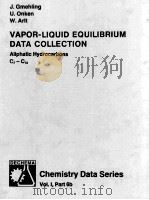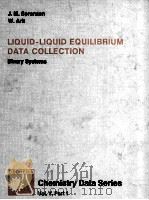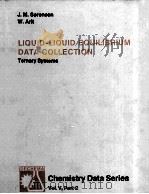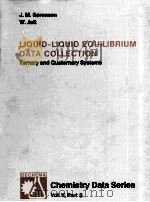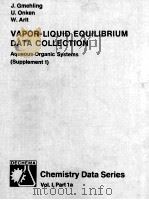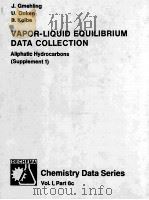《VAPOUR-LIQUID EQUILIBRIUM》
| 作者 | G.STANDART 编者 |
|---|---|
| 出版 | PERGAMON PRESS LONDON·NEW YORK·PARIS·LOS ANGELES |
| 参考页数 | 402 |
| 出版时间 | 没有确切时间的资料 目录预览 |
| ISBN号 | 无 — 求助条款 |
| PDF编号 | 811602958(仅供预览,未存储实际文件) |
| 求助格式 | 扫描PDF(若分多册发行,每次仅能受理1册) |
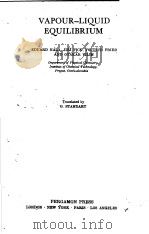
PART Ⅰ.THE THERMODYNAMICS OF SOLUTIONS OF NON-ELECTROLYTES1
1.General Relations3
1.1.The Criterion of Equilibrium3
1.2.One-component Systems4
1.2.1.The Clapeyron Equation5
1.2.2.The Clausius-Clapeyron Equation6
1.3.Multicomponent Systems7
1.3.1.Dependence of Free Enthalpy on the State Variables7
1.3.2.The Chemical Potential8
1.3.3.The Gibbs-Duhem Equation9
1.3.4.Equilibrium in Multicomponent Heterogeneous Systems11
1.3.5.Fugacity12
(a)Dependence of the Fugacity on Pressure and Temperature13
(b)Dependence of Fugacity on Composition15
2.The Ideal Solution16
2.1.Definition of the Ideal Solution16
2.2.Results following from the Definition of the Ideal Solution16
2.3.Vapour-Liquid Equilibrium in Ideal Systems18
2.3.1.Raoult's Law18
2.3.2.Binary Systems18
(a)At Constant Temperature18
(b)At Constant Pressure21
2.3.3.Multicomponent Systems23
3.Real Solutions24
3.1.The Activity and Activity Coefficient24
3.1.1.Definitions and Standard State24
3.1.2.Depeadence of the Activity and Activity Coeffi-cient on the State Variables26
(a)Dependence on Pressure26
(b)Dependence on Temperature27
(c)Dependence on Composition28
4.Vapour-Liquid Equilibrium in Real Systems29
4.1.Constituents Completely Miscible in the Liquid Phase Ideal Vapour Phase29
4.1.1.Mixing and Excess Free Enthalpy31
4.1.2.The Wobl Expansion for the Excess Free Enthalpy33
4.1.3.Dependence of the Activity Coefficients of the Components on the Composition of the Solution—The Wohl,Scatchard-Hamer,van Laar,Margules and Symmetrical Equations34
4.1.3.1.Binary Systems34
4.1.3.2.Ternary Systems57
Graphical Representation of Vapour-Liquid Equilibrium in Ternary Systems61
4.1.3.3.Quaternary Systems63
4.1.3.4.The Benediet,White,Li-Coull and Yu-Coull Equations65
4.1.4.Relative Volatility and the Ratio of the Activity Coefficients67
4.1.4.1.The Margules-Wohl Equation68
4.1.4.2.The Redlich-Kister Equation70
4.1.5.Direct Expression of the Mutual Dependence of the Equilibrium Composition of the Vapour and Liquid Phases80
4.1.6.Dependence of the Composition of the Azeotropic Mixture on Pressure84
4.1.7.Influence of Temperature on Activity Coefficients86
4.2.Constituents Partially Miscible in the Liquid Phase;Ideal Vapour Phase91
4.2.1.Binary Systems91
Determination of the Constants A and B in Equa-tions of the Third Order from Solubility Data94
4.2.2.Ternary Systems97
4.3.Activity Coefficients and Physical Properties of the Pure Constituents103
4.4.Real Vapour Phase104
4.4.1.General Equilibrium Equation105
4.4.2.Equilibrium Ratio K108
4.4.3.Correction for the Real Behaviour of the Vapour Phase at Moderate Pressures110
4.5.Calculation of Vapour-Liquid Equilibrium in Real Systems from Indirect Data112
4.5.1.Binary System at Constant Temperature112
4.5.2.Binary System at Constant Pressure120
Appendix:Values of the functions x/(1—x)and(1—x)/x131
PART Ⅱ.LABORATORY TECHNIQUE145
1.Criteria of Purity of Substances147
1.1.Constants of Heterogeneous Equilibria148
1.1.1.Boiling Point148
1.1.2.△t as a Criterion of Purity of Substances148
1.1.3.Melting Point152
1.1.4.Velocity of Crystallization153
1.1.5.Critical Constants153
1.2.Other Physical Constants153
1.2.1.Density153
1.2.2.Refractive Index153
1.2.3.Viscosity154
1.2.4.Dielectric Constant154
1.3.Chemical Criteria of Purity154
2.Temperature and its Measurement155
2.1.The International Temperature Scale155
2.1.1.Secondary Temperature Standards157
2.2.Mercury Thermometers158
2.2.1.Types of Mercury Thermometers159
2.2.2.Sources of Error for Mercury Thermometers160
2.2.2.1.Correction for Exposed Thread160
2.2.2.2.Influence of Pressure on the Thermometer Reading162
2.2.2.3.Secular Changes of the Position of the Zero Point162
2.2.2.4.Depression of the Zero Point162
2.2.2.5.Inertia of Thermometers163
2.2.2.6.Influence of Radiation164
2.2.3.The Beckmann Thermometer165
2.2.4.Calibration of Thermometers165
2.2.4.1.The Ice Point166
2.2.4.2.The Steam Point166
2.2.4.3.Comparators167
2.3.The Resistance Thermometer168
2.3.1.The Platinum Resistance Thermometer168
2.3.1.1.Description169
2.3.1.2.Calculation of Temperature170
2.3.2.Other Kinds of Resistance Thermometers170
2.3.3.The Measurement of Resistance170
2.4.Thermocouples171
2.4.1.Working Principle171
2.4.2.Types of Thermocouples172
2.4.3.Preparation of Thermocouples173
2.4.4.Measurement of the Thermoelectromotive Force173
2.4.4.1.Deflexion Method173
2.4.4.2.Compensation Method173
2.4.5.Sources of Error174
2.4.6.Calibration of Thermocouples174
2.4.7.Thermobatteries175
3.Pressure and its Measurement177
3.1.Units177
3.2.Measurement of Atmospheric Pressure177
3.2.1.Residual Gas in the Barometer178
3.2.2.Capillary Depression of the Mercury179
3.2.3.Measurement of the Length of the Mercury Column181
3.2.3.1.Compensated Barometers181
3.2.3.2.Parallax181
3.2.4.Temperature Correction182
3.2.5.Influence of Gravity183
3.3.Measurement of Low Pressures183
3.3.1.Open Manometer183
3.3.2.Closed Manometer184
3.3.2.1.Filling of the Manometer185
3.3.3.Zimmerli Manometer187
3.3.4.Open Manometers for Measuring Low Pressures188
3.3.5.Multiplying Manometers189
3.3.5.1.Inclined Manometer190
3.3.5.2.Compensated Micromanometer190
3.3.5.3.Oil Manometers192
3.3.5.4.McLeod Vacuum Gauge193
3.3.5.5.Rotatable McLeod Vacuum Gauge195
3.4.Measurement of High Pressures196
3.4.1.Mercury Columns196
3.4.2.Closed Mercury Pressure Gauge197
3.4.3.Dead-weight Piston Gauge198
3.4.4.Bourdon Pressure Gauge198
3.5.Manostats199
3.5.1.Float Manostats199
3.5.1.1.Cartesian Manostats201
3.5.2.Porous Disk Manostat204
3.5.3.Balance Regulators205
3.5.4.Electrical Pressure Regulators207
3.5.4.1.Compensated Manostat207
3.5.4.2.Contact Manometer208
3.5.4.3.Sulphuric Acid Manostat208
3.5.4.4.Mercury Manostat with Inclined Arm209
3.5.4.5.Two-liquid Manostat209
3.5.4.6.Electronic Relays211
4.Vapour Pressure and Boiling Point213
4.1.Theoretical213
4.1.1.Introduction213
4.1.2.Equations Giving the Dependence of Vapour Pres-sure on Temperature214
4.1.2.1.Antoine Equation215
4.1.2.2.Calingaert-Davis Equation216
4.1.2.3.More Complicated Equations216
4.1.3.Semi-empirical Relations Based on the Clausius-Clapeyron Equation217
4.1.3.1.Crafts Rule217
4.1.3.2.Ramsay-Young Rule217
4.1.3.3.Dühring Rule218
4.1.4.Graphical Methods for Determination of the Dependence of the Vapour Pressure on Temperature218
4.1.4.1.Dühring Diagram219
4.1.4.2.Cox-Othmer Diagram219
4.1.5.Estimation of Critical Data221
4.1.5.1.Guldberg Rule221
4.1.5.2.Meissner and Redding Equations221
4.1.5.3.Further Relations223
4.1.6.Heat of Vaporization224
4.1.6.1.Pictet-Trouton Rule224
4.1.6.2.Kistiakowksy Equation224
4.1.6.3.Calculation of the Heat of Vaporization from the Clapeyron Equation and from Empirical Relations of P0 vs.t224
4.1.6.4.Calculation of the Heat of Vaporization at Low Pressures by use of a Reference Substancs226
4.1.6.5.Watson's Empirical Relation between the Heat of Vaporization and the Critical Temperature226
4.2.Experimental227
4.2.1.Dynamic Method(Measurement of the Boiling Point)227
4.2.1.1.Cottrell Ebulliometer228
4.2.1.2.Washburn Ebulliometer228
4.2.1.3.Swietoslawski Ebulliometer229
4.2.1.4.Measurement of the Condensation Tem-perature231
4.2.1.5.Standard Types of Ebulliometers232
4.2.1.6.Procedure for Measuring the Degree of Purity with a Differential Ebulliometer233
4.2.1.7.Sensitivity of Ebulliometric Measure-ments to Pressure changes234
4.2.1.8.Ebulliometer for Homogeneous Mixtures of Liquids234
4.2.1.9.Measurement of the Boiling Point of Heterogeneous Mixtures236
4.2.1.10.Determination of the Mutual Solubility of the Constituents of Binary and Ternary Systems at the Boiling Point237
4.2.2.Static Method238
4.2.2.1.Isoteniscope238
4.2.2.2.Measuring the Vapour Pressure of Non-volatile Liquids240
4.2.3.Micromethods240
4.2.3.1.Smith-Menzies Method240
4.2.3.2.Other Micromethods242
4.2.4.Certain Less Frequently Used Methods242
4.3.Treatment of the Experimental Data243
4.3.1.Preliminary Judging of the Experimental Data244
4.3.2.Preliminary Graphical Smoothing of Experimental Data244
4.3.2.1.Procedure with a Large Number of Points248
4.3.3.Procedure for the Numerical Smoothing of Experi-mental Data by the Method of Least Squares248
5.Direct Experimental Determination of Vapour-Liquid Equi-librium253
5.1.Distillation Method254
5.2.Circulation Method254
5.2.1.Stills with Circulation of the Vapour Phase256
5.2.1.1.Othmer Still and its Modifications256
5.2.1.2.Two-plate Still262
5.2.1.3.Jones Still and its Modifications263
5.2.1.4.Determination of Equilibrium in Systems with Limited Miscibility265
5.2.1.5.Measurement of Equilibrium at Low Pressures267
5.2.1.6.Measurement of Equilibrium at High Pressures268
5.2.2.Stills with Circulation of the Vapour and Liquid Phases269
5.2.2.1.Gillespie Still and its Modifications269
5.2.2.2.Altsheler Still274
5.2.2.3.Scatchard Still275
5.2.2.4.Ellis Still276
5.2.2.5.Thornton Still276
5.3.Static Method277
5.4.Dew and Bubble Point Method278
5.4.1.Cell for Determination of the Dew and Bubble Points279
5.5.Flow Method281
5.5.1.Colburn Flow Still281
5.5.2.Cathala Dynamic Ebulliometer282
5.5.3.Simple Flow Still284
5.5.4.High-Pressure Elow Still285
5.6.Evaluation of Stills and Methods for the Direct Determi-nation of Vapour-Liquid Equilibrium287
5.7.Consistency of Measured Data287
Appendix:295
Diagram 1.Generalized Compressibility Factor of Gases and Vapours295
Diagram 2.Generalized Fugacity Diagram296
Diagram 3.Generalized Expansion Factor Diagram296
PART Ⅲ.VAPOUR-LIQUID EQUILIBRIUM DATA297
Alphabetical Index According to the Constituents of the Systems299
References367
PART Ⅰ1
1.Determination of the constants in the van Laar equations of the third order38
2.Determination of the constants of the van Laar third-order equations from several direct determinations of the equili-brium vapour-liquid composition39
3.Calculation of the constants A and B in the van Laar equa-tions of the third order from the known boiling point and composition of the azeotropic mixture41
4.Calculation of the constants A and B in the van Laar equa-tions of the third order from indirect data according to Carlson and Colburn42
5.Calculation of the constants A and B in the van Laar equa-tions of the third order from indirect data(from the"t-x"curve and from the dependence of the vapour pressures of the pure constituents on temperature)47
6.Determination of the constants in Margules equations of the third order for a ternary system58
7.Determination of the constants b and c in the Redlich-Kister equation of the third order from direct determinations of the equilibrium composition71
8.Determination of the constants b and c in the Redlich-Kister equation of the third order from the known isother-mal dependence of the pressure of the saturated vapours on the composition of the liquid phase73
9.Characterization of a ternary system by the Redlich-Kister equation of the third order75
10.Composition of the azeotropic mixture at various conditions84
11.Recalculation of a constant in a third-order equation to a different temperature(from the value for 80℃ to the value for 20℃)89
12.Characterization of a binary system with limited miscibility92
13.Calculation of the constants A and B in the van Laar equa-tions of the third order from solubility data96
14.Characterization of a ternary system with limited miscibility99
15.Calculation of the equilibrium ratio of benzene in a mixture of aromatic hydrocarbons at 200℃ and a total pressure of 10 atm(with the aid of the generalized fugacity diagram)109
16.Calculation of the equilibrium ratio of benzene in a mixture of aromatic hydrocarbons at 200℃ and a total pressure of 10 atm111
17.Calculation of the equilibrium composition of the liquid and vapour-phases from isothermal indirect data116
18.Calculation of the vapour-phase composition of a binary system from indirect isobaric data128
PART Ⅱ145
1.Correction of the reading of a mercury thermometer for the exposed thread160
2.Correction of the reading of a mercury thermometer for the exposed thread160
3.Inertia of thermometers164
4.Crafts rule217
5.Ramsay-Young rule217
6.Ramsay-Young rule218
7.Determination of the critical parameters from the normal boiling point223
8.Determination of the molar heat of vaporization from the normal boiling point and critical parameters225
9.Caloulation of the molar heat of vaporization from the normal boiling point226
10.Numerical smoothing of measured data on vapour pressure by the method of least squares251
《VAPOUR-LIQUID EQUILIBRIUM》由于是年代较久的资料都绝版了,几乎不可能购买到实物。如果大家为了学习确实需要,可向博主求助其电子版PDF文件(由G.STANDART PERGAMON PRESS LONDON·NEW YORK·PARIS·LOS ANGELES 出版的版本) 。对合法合规的求助,我会当即受理并将下载地址发送给你。
高度相关资料
-

- PHYSICAL SCIENCES DATA 7 LIQUID-LIQUID EQUILIBRIUM AND EXTRACTION PART B
- 1981 ELSEVIER SCIENTIFIC PUBLISHING COMPANY
-
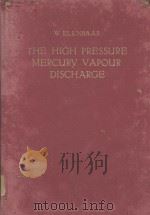
- THE HIGH PRESSURE MERCURY VAPOUR DISCHARGE
- 1951 NORTH-HOLLAND PUBLISHING COMPANY
-

- GROWTH OF CRYSTALS FROM THE VAPOUR
- 1974 CHAPMAN AND HALL
-

- EQUILIBRIUM CONSTANTS OF LIQUID-LIQUID DISTRIBUTION REACTIONS PART IV:CHELATING EXTRACTANTS
- 1978 PERGAMON PRESS
-
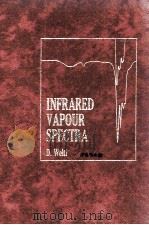
- INFRARED VAPOUR SPECTRA
- 1970 HEYDEN & SON LTD
-
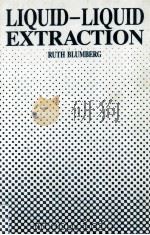
- Liquid-Liquid Extraction
- 1988 ACADEMIC PRESS
提示:百度云已更名为百度网盘(百度盘),天翼云盘、微盘下载地址……暂未提供。➥ PDF文字可复制化或转WORD
